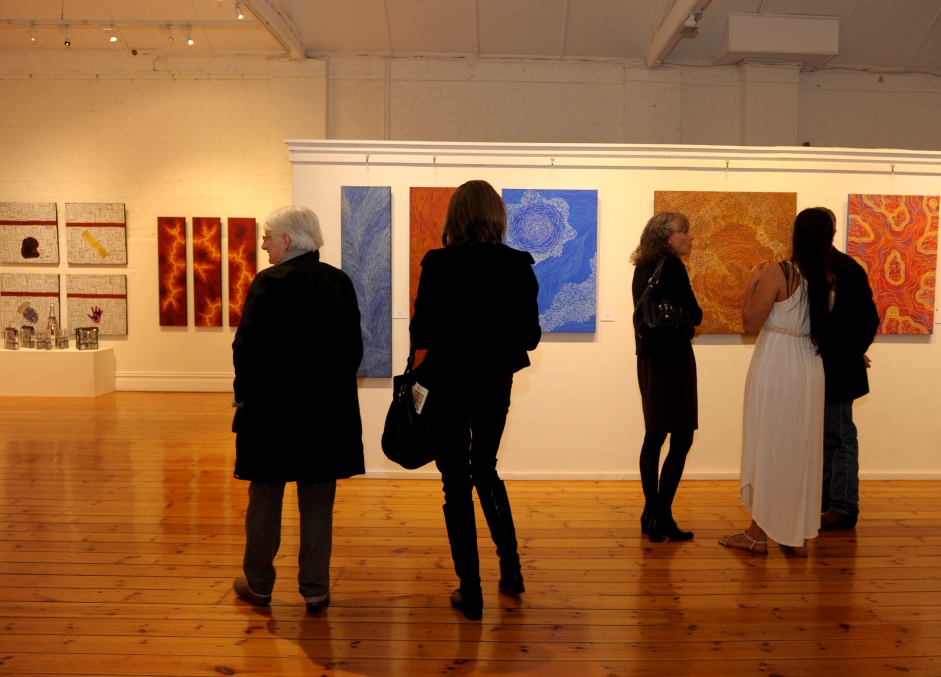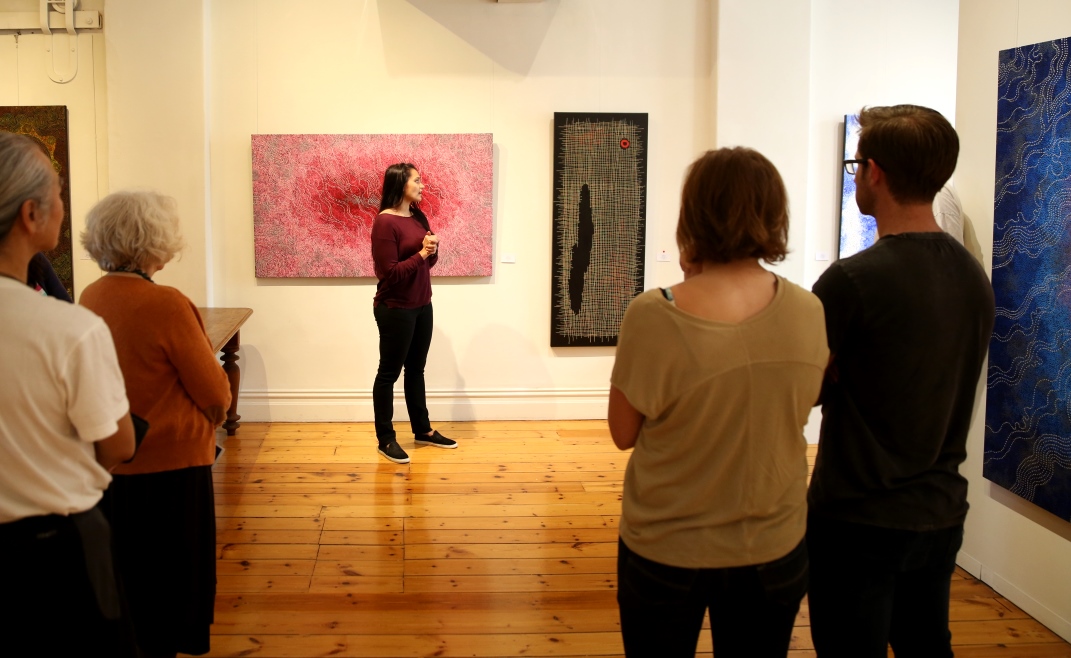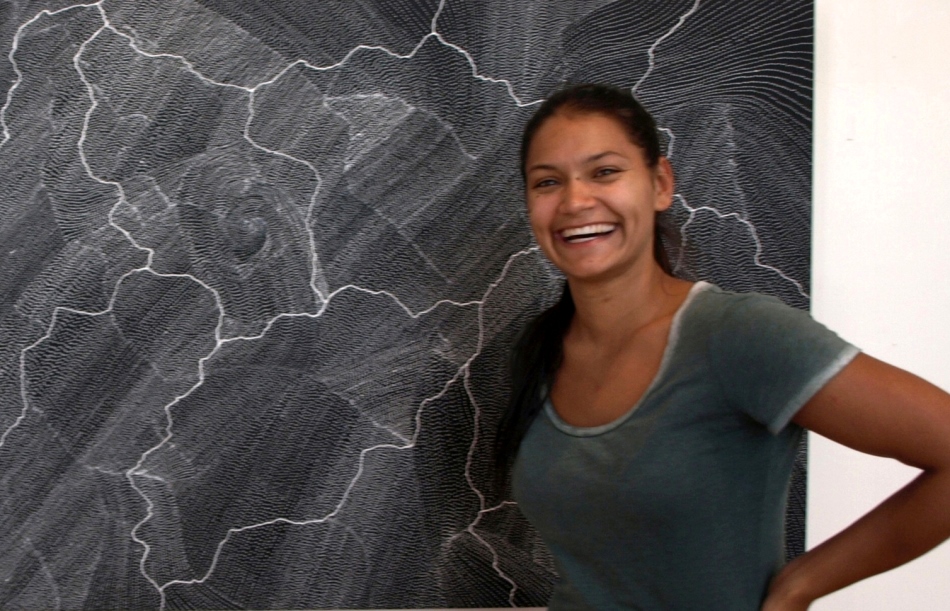Indigenous Culture In Schools: Sarrita King’s Perspective
By: David Wroth, Japingka Gallery, 2016

Sarrita King has paintings in major Australian and international art collections. In this article she discusses how she would like to see Aboriginal art explored in schools. She has a message for teachers.
What did you see being taught about Australian indigenous culture at school?
I feel like I was informed but I don’t know whether that was from a school point of view. In Darwin it’s always been multicultural. I’ve got a younger sister who still goes to school now. It seems they’re much more likely to be separated into different groups. Back then you had a friend from everywhere.
There’s a massive Greek community, there’s a lot of Indonesians, Chinese and Japanese. You knew everybody, everyone was friends. Aboriginal people were always around. So for us seeing Aboriginal culture and also going out bush on school holidays, I felt very entrenched.
From a school point of view, I think the most Australian history I was taught was the Captain Cook thing. I don’t remember any Aboriginal history. When it came to Australian history it was all about the explorers and their discoveries. It didn’t stick. It was more drilled into you rather than it being a learning experience. It never captured me, but maybe I wasn’t a good history student.

In the last few years, you’ve done some work in schools. What sort of things did you do?
Working in schools has been great. We’ve visited everything from public schools to the high-end private schools. You get a classroom full of kids. Some are just champing at the bit to tell you about the Aboriginal art they’ve got at home. They want to ask you all about your pictures and want to touch the artworks, which is fine. I don’t mind any of that. I think it’s good they want to pick your brain. Then you have other kids who are quiet. They have no idea about Aboriginal art or Aboriginal culture. We go into those schools and we talk about different artworks. We show them artworks from some of the most famous artists.
We show them different techniques that people use and the stories behind them. We use some artworks that have a strong use of symbols. This helps with the practical side of things. The kids open up, we talk about the use of symbols in the artworks and how they’re used to tell a story. Then we invite the children to use those symbols to tell their own story.
Their story might be about immigration. They’ll use a campsite to symbolise where their family originated from. There might be travelling lines to another campsite which is in Australia. Then they’ll draw their family and usually they’ve immigrated from England or somewhere overseas. They’ll put the beaches where people might have landed. It engages the kids not only to use the symbols but to understand them. At the end we invite the kids to swap and share their stories with each other. They sit in a group and tell everybody about their artwork. I like it because it helps them find their own storytelling voice.
Working in schools has always been a positive experience for me and the teachers love it. I think the hardest part about it is getting the paint out of the uniforms at the end. I do feel a bit bad about that.

What have you learnt from these classroom experiences?
I think the kids have a willingness to engage. They love moving to the practical side of it. I hope that they take away an experience they’ll remember. We’ve had kids from schools then come to exhibitions. Their parents tell us they’ve gone home and raved about it and then dragged their Mum down to an exhibition. Sometimes the parents end up walking out with this massive painting. I feel a bit bad because that parent had no idea what they were getting themselves into. It’s good to see it resonating so strongly with the children that they want to share it. They go home and they talk about it. That’s the best.
The children also produce their own original artwork in the classes and they are proud of that. We had somebody come down to an exhibition and tell us, “You went to my daughter’s school and I’ve now got my child’s own painting in my office. She demanded that I put it there.” I think that’s great. It brings people in, and it’s a good talking point.

What do you want teachers to understand when they approach the topic of Aboriginal art?
I think I’d like to say they don’t have to know it all. Try to approach it from the points of technique and story. Art teachers can break it down by looking at the art techniques used. Every Aboriginal artwork comes with a story that can be shared. You can look at an image and ask students what they think. I reckon it would be an engaging thing for the students as well.
I’m just thinking about the Bush Medicine Lesson Plans on the Japingka Education page. You can talk about bush medicine leaves. You can talk about how they think that the artist would have done the leaves. You can ask how has she created that movement and what gives it the level of depth it has. When you break it down to that individual element of the leaf, you think, “Oh it’s such a simple thing”. Then students get to see that put together it creates a beautiful sense of movement. It becomes a real thing of beauty. Rosemary’s whole family paint the bush medicine leaves because they are so beautiful.
These are discussions you can open up with a class. I think there’s nothing wrong with that. There’s nothing you can be respectful about in artwork if you ask people what they feel about it. If you talk about it for what it is and what you’re seeing. I think this is especially true when you talk about symbols. It’s so engaging. I think the more visual tools you use when you talk about art or the artworks the better. And also the scope, like you can talk about traditional works as well as the more contemporary art of today.
I think a lot of the time you’ve got to let students come to their own conclusions. That’s them engaging and them bringing their own thoughts into what they’re seeing. They can decide what they like. That’s one thing about Aboriginal art – you’re not going to like everything. But there’s something in Aboriginal art for everybody.

If you could speak to these teachers, what would be your message?
Don’t be afraid. Art is inclusive, not exclusive. When you approach it, talk from your own experience and what you feel about the artwork. Every child will feel something different. They’ll look at a painting and interpret it in different ways but that’s what art is about. I think that’s the number one thing, don’t be afraid. Invite people in. It’s such an inclusive art practice and an inclusive culture. If you sat with most of the artists, they’d love for you to sit with them. They’d talk to you. They’d engage with you. So why not create that engagement and the talking in a classroom. If you went to Alice Springs and went to see an artist at work – they’d love for you to just spent time with them. They’re so inclusive. Just don’t be afraid.
What’s your dream for education about Indigenous culture in Australia?
I’d like to see a truthful history, about every facet. I want people to, when asked at age 10, “What is Australian history? What is Australian culture?” I want them to say Aboriginal culture. I believe that every single person should be proud and feel a sense of ownership towards it. If I talk about Australian culture, Aboriginal culture, I am proud to live in a country that has such a long history. This should be the case whether they are Aboriginal or not. That’s amazing beauty that we’re so lucky to be enriched by. Even today we are still influenced by it. This might be through art, dance or just knowing that we are in the vicinity of such a rich culture that’s still living today.

That’s what I want. For schools to teach every child it’s something to be proud of. We need to be informed of what happened in the past. Through information we’ll get the solutions to any issues that are perceived. This younger generation coming through are the ones that are going to solve any problems going forward. Without the right information, they’re never going to know how it all interconnects. We need a true history about colonisation. It needs to tell us what happened right through to where we’re at now. This helps all of us understand why we have the issues we have now. It needs to be an absolute embracing of the fact that we still are able to connect to it, every Australian. Every person who comes to visit Australia can go and enjoy a 60,000 year culture that’s still living. That’s something to be proud of. I think that’s what I want for education. I want there to be an Indigenous footprint that is something to be uplifted by and feel proud of.
If you are a teacher I don’t think you should be afraid to say, “I don’t know”. If a child has some question that you just can’t answer, say “I’m not sure, what do you think?”. You can always put it back to the student too. That creates an ongoing discussion and hopefully something burning in them. They’ll go off and Google it and try to get the answer to their own question. There’s no shame in saying, “I don’t know”.
